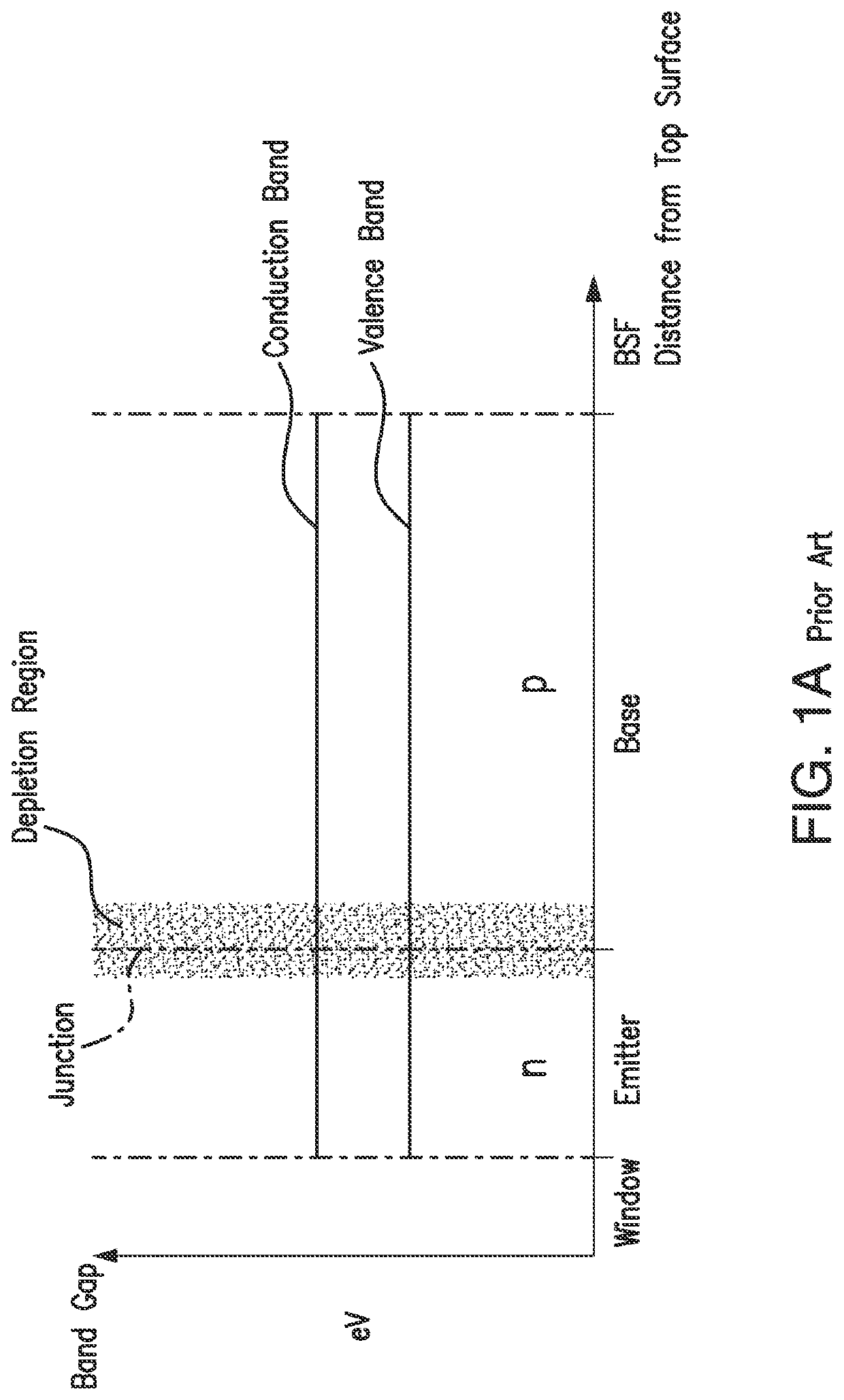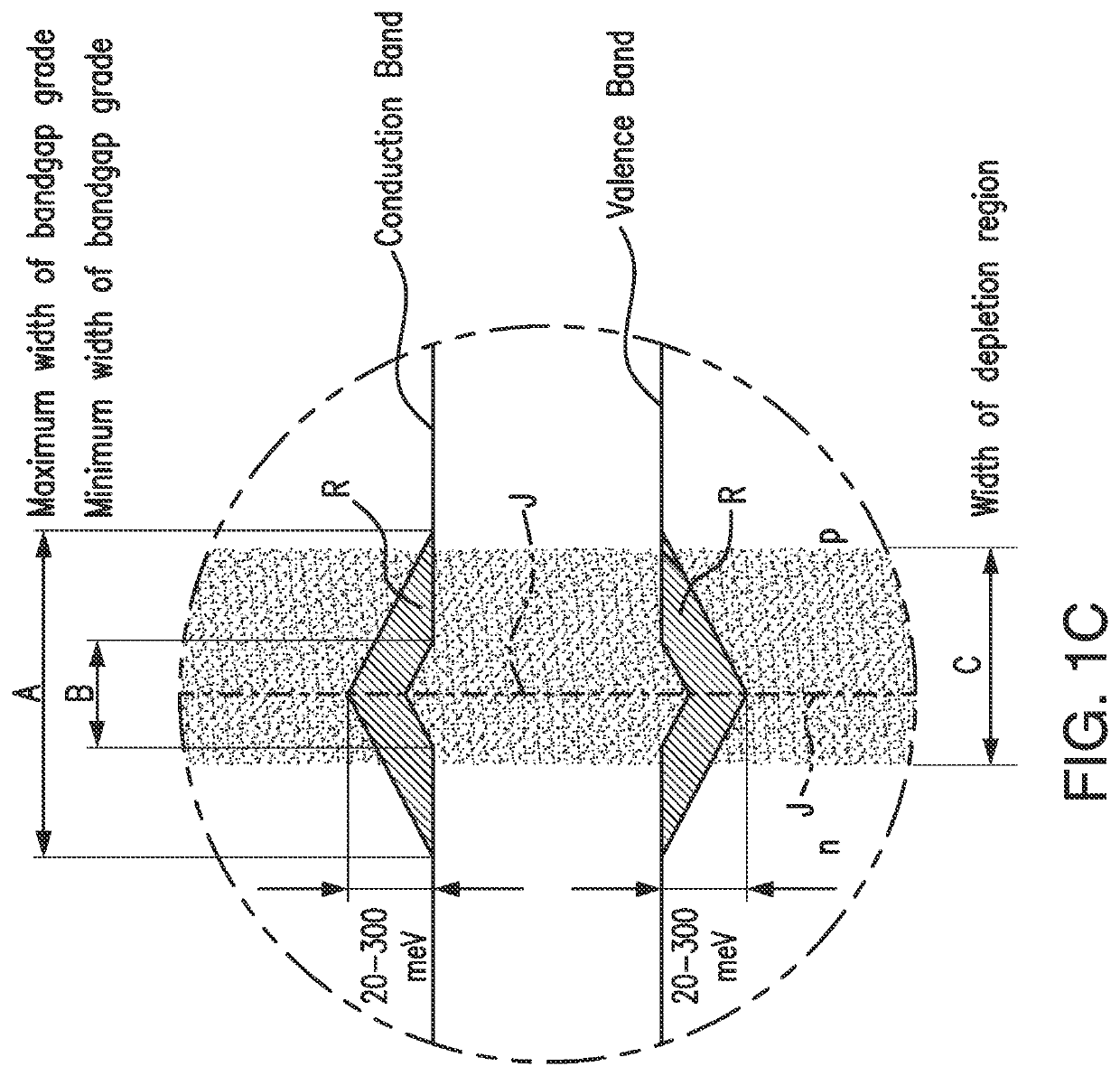Multijunction solar cells
a solar cell and multi-junction technology, applied in the field of solar cells and the fabrication of solar cells, can solve the problems of affecting the performance of solar cells, the occurrence of anomalous events in photovoltaic arrays, and the difficulty of properly specifying and manufacturing
- Summary
- Abstract
- Description
- Claims
- Application Information
AI Technical Summary
Benefits of technology
Problems solved by technology
Method used
Image
Examples
second embodiment
[0166]FIG. 1H is a and graph illustrating the band gap throughout the thickness of a solar subcell similar to that of FIG. 1B in a multijunction solar cell according to the present disclosure, in which the band gap is graded both in the emitter and base regions, in which in the emitter region it increases from the nominal band gap such as shown in FIG. 1A to a plateau at a higher band gap around the junction, and then decreases in the base region back down to the nominal band gap.
[0167]In some embodiments, the gradation in band gap increases to a certain level that is 20 meV to 300 meV greater than the nominal level, and then remains constant and plateaus at that level in the emitter region and continues at that level into the base regions symmetrically (or in other embodiments, non-symmetrically) around the junction. The gradation in band gap then decreases in the base region to the nominal band gap level as depicted in FIG. 1H.
third embodiment
[0168]FIG. 2A is an enlarged view of the band diagram around the junction and the depletion region of solar subcell similar to that of FIG. 1F depicting a graded band gap in that solar subcell according to the present disclosure in which the solar subcell is: (i) a homojunction; (ii) the band gap at the junction is greater than the band gap in both the n and p ungraded active region; (iii) the gradation in the band gap is symmetric around the junction with the width of the graded region in the n region being equal to the width of the graded region in the p region; (iv) the depletion region is asymmetric around the junction; (v) the width of the depletion region is shorter in the n region than in the p region; and (vi) the aggregate width of the depletion region is equal to the width of the region with a gradation in band gap.
[0169]Although the illustration in FIG. 2A is an embodiment with characteristics (i) through (vi) above, the present disclosure contemplates further variants of...
fourth embodiment
[0170]FIG. 2B is an enlarged view of the band diagram around the junction and the depletion region of solar subcell similar to that of FIG. 1F depicting a graded band gap in that solar subcell according to the present disclosure in which the solar subcell is: (i) a homojunction; (ii) the band gap at the junction is greater than the band gap in both the n and p ungraded active region; (iii) the gradation in the band gap is symmetric around the junction with the width of the graded region in the n region being equal to the width of the graded region in the p region; (iv) the depletion region is asymmetric around the junction; (v) the width of the depletion region is shorter in the n region than in the p region; and (vi) the aggregate width of the depletion region is equal to the width of the region with a gradation in band gap.
[0171]Although the illustration in FIG. 2B is an embodiment with characteristics (i) through (vi) above, the present disclosure contemplates further variants of...
PUM
| Property | Measurement | Unit |
|---|---|---|
| band gap | aaaaa | aaaaa |
| band gap | aaaaa | aaaaa |
| band gap | aaaaa | aaaaa |
Abstract
Description
Claims
Application Information
 Login to View More
Login to View More - R&D
- Intellectual Property
- Life Sciences
- Materials
- Tech Scout
- Unparalleled Data Quality
- Higher Quality Content
- 60% Fewer Hallucinations
Browse by: Latest US Patents, China's latest patents, Technical Efficacy Thesaurus, Application Domain, Technology Topic, Popular Technical Reports.
© 2025 PatSnap. All rights reserved.Legal|Privacy policy|Modern Slavery Act Transparency Statement|Sitemap|About US| Contact US: help@patsnap.com



